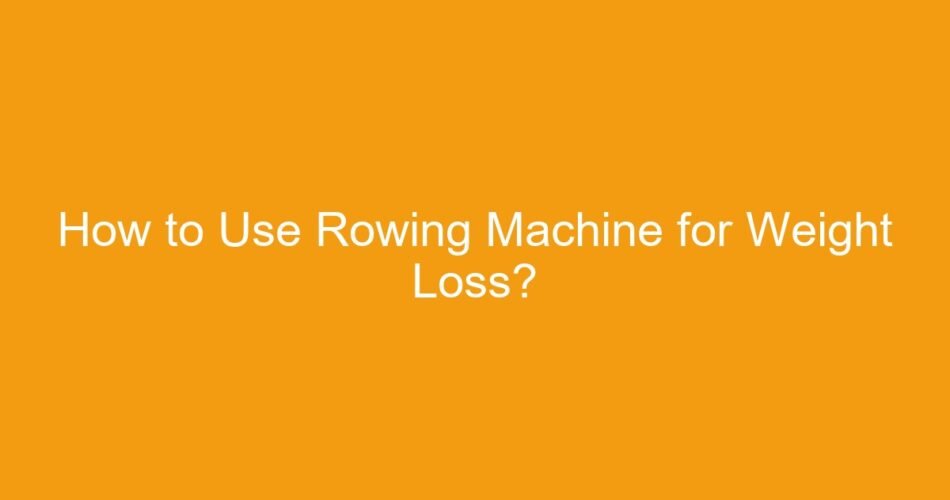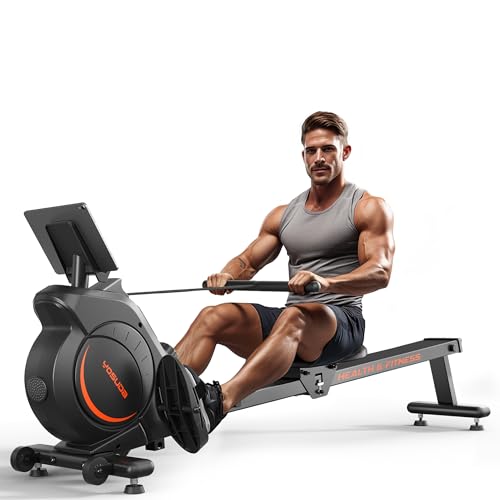Discover how to use rowing machine for weight loss and maximize your results. This low-impact, total body cardio exercise is a calorie-burning powerhouse when applied with proper technique and the right workout structure.
The most effective approach to address how to use rowing machine for weight loss is by implementing high-intensity interval training (HIIT) coupled with consistent, proper technique. The rowing stroke engages approximately 86% of the body’s muscle mass, making it one of the most efficient cardiovascular exercises available for rapid calorie expenditure. Utilizing both strength and stamina in a single movement accelerates your metabolic rate, providing significant benefits for weight management and long-term body composition goals.
Calorie Burn and Metabolic Advantage
The rowing machine, often called an “ergometer” or “erg,” stands out among cardio equipment due to its unparalleled muscle recruitment. Unlike cycling or running, which primarily engage the lower body, rowing forces cooperation between major upper body, core, and lower body muscle groups simultaneously. This massive recruitment demands enormous energy, translating directly into superior calorie burn.
🛒 Recommended Product
According to exercise physiology data, a person weighing 185 pounds can burn over 800 calories per hour rowing vigorously. This high expenditure creates the necessary calorie deficit required for effective weight loss. Furthermore, the intensity of the workout maximizes the post-exercise oxygen consumption (EPOC), commonly known as the “afterburn effect.” This means your body continues to burn calories at an elevated rate long after you finish the session, significantly boosting the metabolic benefits compared to steady-state activity.
To achieve maximum calorie expenditure, focus on consistent power output and maintain a stroke rate (SPM) between 24 and 30, depending on the workout type.
Essential Rowing Technique for Maximum Effect
Incorrect stroke technique is the most common reason users fail to maximize weight loss benefits and risk injury on a rowing machine. Effective fat loss relies on engaging the major muscle groups in the correct sequence, often described as the 60/20/20 rule: 60% legs, 20% core, and 20% arms.
The perfect stroke is divided into four critical phases:
- The Catch: Hips and knees are compressed, arms are extended, and shins are vertical. This is the setup phase.
- The Drive: This is the power phase. Initiate the movement solely by pushing hard through your feet, extending the legs first. Once the legs are nearly straight, hinge slightly backward at the hips (the core engagement), and finally, pull the handle to your sternum with the arms.
- The Finish: Legs are straight, the core is braced, and the handle rests lightly against the body. This is a moment of maximal muscle contraction.
- The Recovery: Reverse the order. Push the arms back out first, then hinge the body forward (core), and lastly, bend the knees, sliding back toward the catch position.
Crucially, avoid ‘scooping’ or ‘rushing the recovery’. Rushing back immediately after the pull minimizes the effective engagement of the large muscle groups and strains the lower back. The recovery phase should take approximately twice as long as the powerful drive phase.
Sample Workouts: HIIT and Steady State
For robust weight loss, a comprehensive program must include both High-Intensity Interval Training (HIIT) and sustained Steady State cardio. Both techniques offer distinct metabolic advantages.
1. High-Intensity Interval Training (HIIT Rowing)
HIIT is superior for boosting EPOC and improving cardiovascular fitness rapidly. Due to the high intensity, these sessions should be kept shorter, typically 15–25 minutes, and performed 2–3 times per week.
🛒 Recommended Product
Example HIIT Workout (The Tabata Model):
* Warm-up: 5 minutes of light rowing (18–20 SPM).
* Intervals (4 Rounds total): 20 seconds of maximum effort (sprint), followed by 10 seconds of complete rest or very slow recovery rowing.
* Rest: After 8 intervals (4 minutes), rest for 2 minutes.
* Total Time: 18–20 minutes.
2. Steady State Cardio (LISS Rowing)
Long, slow, distance (LISS) rowing is essential for developing endurance and increasing the total duration your body spends in the optimal fat-burning zone. These sessions are lower intensity, allowing you to sustain the effort for 30 to 60 minutes.
Example Steady State Workout:
* Duration: 45 minutes straight.
* Intensity: Maintain 65%–75% of maximum heart rate. You should be able to speak in short sentences, but not comfortably hold a conversation.
* Focus: Perfect technique and consistent pace over the duration.
Combining these two training styles provides the best approach for maximizing calorie burn while preventing adaptation plateaus.
| Feature | Steady State Cardio (LISS) | High-Intensity Interval Training (HIIT) |
|---|---|---|
| Primary Goal | Endurance, Sustained Fat Oxidation | Metabolic Spike, EPOC (Afterburn) |
| Duration | 30–60 minutes | 15–25 minutes |
| Intensity | Moderate (60–75% Max HR) | Alternating Max Effort (85%+ Max HR) |
| Recovery Time | Minimal Rest Needed | Requires 48 hours for full recovery |
| Calorie Profile | High volume of calories burned during session | High volume of calories burned post-session |
Integrating Rowing for Long-Term Weight Management
While understanding the mechanics of how to use rowing machine for weight loss is critical, long-term success requires consistency and integration into a broader lifestyle plan. Rowing machines, unlike traditional gym equipment, offer a challenging yet accessible workout for almost anyone, regardless of fitness level.
Consistency means aiming for 3 to 5 sessions per week. Because rowing is low-impact, it places minimal stress on the joints, making it ideal for those managing older injuries or significant body weight. This reduced impact allows for higher training frequency compared to high-impact activities like running.
For optimal body composition change, pair your rowing regimen with adequate protein intake and caloric awareness. Since rowing builds muscle across the back, arms, and legs, fueling that muscle growth with diet is crucial. The more lean muscle mass you carry, the higher your resting metabolic rate becomes, turning your body into a more efficient fat-burning machine even when you are not actively exercising.
🛒 Recommended Product
By ensuring every stroke follows the correct drive sequence—legs, core, arms—and by strategically balancing intense interval training with longer endurance pieces, you maximize the efficiency of this powerful cardiovascular exercise for sustained weight loss. Understanding the best methods for using the rowing machine for weight loss ensures that every minute spent on the water—or the erg—is maximized for measurable results.
Scientific References & Research
The following peer-reviewed research papers provide additional scientific context:
-
GE Chapman (1997).
Making weight: Lightweight rowing, technologies of power, and technologies of the self
[External Link] -
H De las Casas et al. (2019).
Eccentric training with a powered rowing machine
[External Link] -
IA Bernstein et al. (2002).
An ergonomic comparison of rowing machine designs: possible implications for safety
[External Link]
Note: External research links are provided for educational purposes and do not necessarily represent endorsement.
Frequently Asked Questions About How to Use Rowing Machine for Weight Loss?
Q. What is the optimal damper setting on the rowing machine for maximizing calorie burn and fat loss?
A. The damper setting should generally be kept in the medium range (3–5) for weight loss, as this balances resistance with stroke rate, allowing for longer, sustainable workouts. A high damper setting is more taxing on muscles and can lead to quick fatigue, while a low setting may not provide enough resistance for effective calorie expenditure.
Q. Should I focus more on long, slow rows or shorter, high-intensity interval training (HIIT) sessions for weight loss?
A. The most effective strategy combines both long, moderate-intensity rows (steady-state) and shorter, intense HIIT sessions throughout the week for maximum metabolic effect. Steady-state rowing builds endurance and burns fat during the workout, while HIIT boosts your metabolism (EPOC) for increased calorie burn hours afterward.
Q. How important is proper rowing technique to ensure I am effectively burning calories and preventing injury during weight loss workouts?
A. Proper technique is fundamentally crucial; it engages 86% of your muscle mass—including legs, core, and arms—to ensure maximum caloric expenditure and prevent strain. Focusing on the powerful leg drive (the “catch” and “drive” phases) ensures you maximize energy usage while protecting your lower back and knees from injury.
Q. Besides the workout itself, what nutritional considerations are essential when using the rowing machine specifically for weight loss?
A. To optimize weight loss, your nutrition must create a consistent calorie deficit while ensuring adequate protein intake to support muscle recovery and growth. Prioritize whole foods and complex carbohydrates pre-workout for energy, and consume protein immediately post-workout to repair muscle tissue.
Q. How can I track my progress effectively using the rowing machine’s monitor to ensure I am meeting my weight loss goals?
A. Focus on tracking metrics like total distance covered, average split time (time taken to row 500 meters), and total calories burned per session to monitor fitness improvement. As you get fitter, your split time should decrease and your distance covered should increase within the same workout duration.
Q. What are some signs that I am overtraining or rowing too intensely, which could hinder my weight loss progress?
A. Signs of overtraining include chronic fatigue, elevated resting heart rate, persistent muscle soreness that doesn’t resolve, and plateauing weight loss despite consistent effort. If these occur, reduce your intensity or frequency for a few days to allow for proper recovery and avoid burnout.
Related Articles
What Is the Best Workout Machine for Weight Loss?
Trying to determine what is the best workout machine for weight loss? While several options deliver results, the rowing machine often provides the max…
Do Vibrating Weight Loss Machines Work?
Do vibrating weight loss machines work? The scientific data is clear: while these vibration therapy plates offer proven benefits like muscle stimulati…
Treadmill Workouts for Buttocks: Sculpt and Tone Your Glutes
Getting fit and shaping your buttocks can be challenging. Treadmill workouts might be the solution you need. Treadmill workouts are not just for cardi…
When you purchase a product through Amazon links on EllipticalKing.com, we may earn a small commission at no extra cost to you. This helps support the site and keep our content free.




